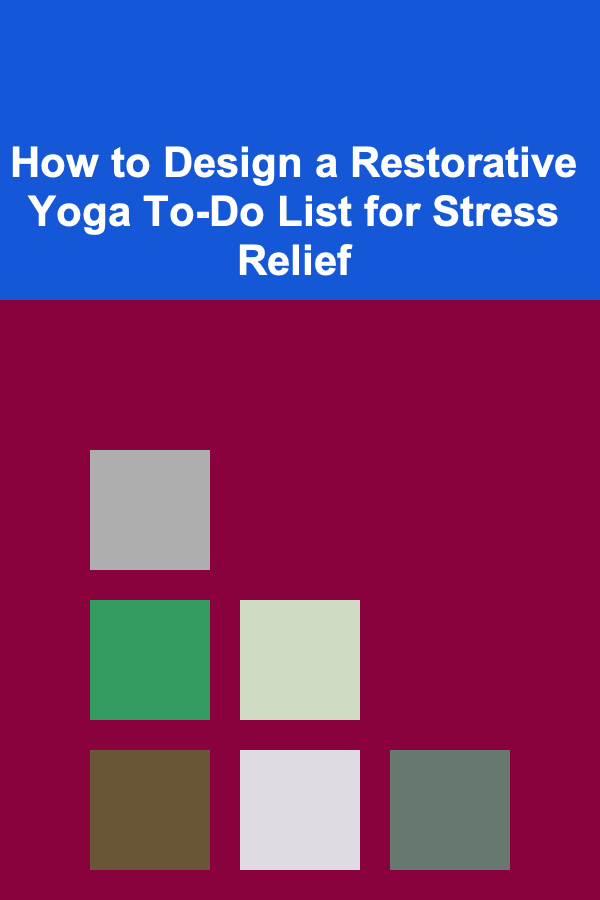
How to Design a Restorative Yoga To-Do List for Stress Relief
ebook include PDF & Audio bundle (Micro Guide)
$12.99$10.99
Limited Time Offer! Order within the next:

Stress is a constant part of modern life, and while there are various ways to deal with it, one of the most effective and sustainable methods is through restorative yoga. This gentle form of yoga focuses on relaxation, healing, and stress relief by using postures that are held for longer periods, allowing the body and mind to fully relax and release tension.
Restorative yoga is accessible to everyone, regardless of their experience with yoga or fitness. It is particularly beneficial for those experiencing high levels of stress, burnout, or anxiety. The purpose of restorative yoga is not to build strength or increase flexibility, but to deeply relax the body and restore mental calmness. To help you design an effective restorative yoga routine, this article will provide detailed insights into creating a restorative yoga to-do list that targets stress relief.
Set Clear Intentions for Your Practice
Before beginning your restorative yoga session, it is crucial to set a clear intention. Your intention will serve as a guide throughout the practice and help you remain focused on the goal of stress relief. The intention could be something like "Letting go of tension," "Finding peace within," or "Releasing the weight of the day."
Why It Matters:
Setting an intention helps to anchor the mind and body, aligning your practice with a purpose. It enhances the effectiveness of the practice by focusing your energy and attention on what you aim to achieve---stress relief, relaxation, or simply being present.
Action Steps:
- Take a few moments to reflect on what you want to achieve with your practice.
- Write down your intention or repeat it silently before you begin.
- Keep your intention in mind throughout the practice, especially if your thoughts begin to wander.
Start with a Mindful Breathing Exercise
The foundation of restorative yoga lies in breathwork. Deep, mindful breathing activates the parasympathetic nervous system, promoting relaxation and helping to reduce stress hormones like cortisol. Practicing deep breathing before starting your yoga poses sets the tone for a calm and focused session.
Why It Matters:
Breathing exercises not only promote relaxation but also help to clear the mind, bringing attention to the present moment. This sets the stage for a more grounded and peaceful yoga practice.
Action Steps:
- Begin by sitting in a comfortable position (cross-legged or on your heels).
- Close your eyes, inhale deeply through your nose for a count of four, and exhale slowly through your mouth for a count of six.
- Continue this breathing cycle for 5-10 minutes, focusing on the sensation of the breath as it enters and leaves your body.
Choose Gentle, Restorative Poses
Restorative yoga involves gentle, supported postures that encourage relaxation. Unlike traditional yoga, where poses are held for a few breaths, restorative poses can be held for several minutes to allow the body to fully relax into them. These poses should be designed to reduce muscle tension, release stored stress, and support mental relaxation.
Why It Matters:
The primary goal of restorative yoga is to deeply relax the body, which can only happen when the body is supported and allowed to remain in poses for longer periods. These restorative poses stimulate the nervous system to enter a state of rest, leading to a significant reduction in stress.
Action Steps:
- Select 4-6 restorative poses that focus on different parts of the body.
- Use props like bolsters, blankets, or pillows to support your body, ensuring that you feel completely comfortable.
- Focus on poses that allow your body to open and release tension, such as:
- Supta Baddha Konasana (Reclining Bound Angle Pose)
- Viparita Karani (Legs Up the Wall Pose)
- Supported Child's Pose (Balasana)
- Supported Savasana (Corpse Pose)
- Reclining Twist
Why These Poses Matter:
These poses are specifically designed to target relaxation and stress relief. For instance, Supta Baddha Konasana opens the hips and chest, while Viparita Karani is excellent for calming the nervous system and improving circulation.
Incorporate Guided Meditation or Visualization
To enhance the stress-relieving effects of your practice, include a brief meditation or visualization session after holding your restorative poses. Guided meditation can help to calm the mind, reduce anxiety, and create a sense of inner peace. Visualization is a powerful technique that uses the mind's eye to picture a calming environment or positive outcome, which can be incredibly soothing.
Why It Matters:
Meditation and visualization help to reduce mental chatter, allowing the mind to rest. In moments of deep relaxation, the subconscious mind is more open to positive suggestions and healing, which makes stress relief more effective.
Action Steps:
- Find a comfortable seated position or lie down in a supported pose.
- Focus on your breath and allow your mind to quiet.
- Visualize a peaceful place or imagine yourself letting go of stress and tension with each exhale.
- If you prefer, listen to a guided meditation that focuses on relaxation or stress release.
Use Props for Support
Props are an essential part of restorative yoga. They offer the support necessary to allow your body to fully relax in the poses. This is particularly important if you're new to yoga or have any physical discomfort or injuries. Bolsters, blankets, and blocks provide additional comfort and ensure that the poses are fully supported.
Why It Matters:
Using props helps to alleviate any discomfort, making the restorative poses more accessible and effective. When your body is comfortable and supported, you can fully release tension and allow the body to rest deeply.
Action Steps:
- Gather a variety of props, including a bolster (or firm pillow), blankets, yoga blocks, and straps.
- Place props strategically under your body in poses where support is needed, such as under the knees in a restorative backbend or under the head in Supta Baddha Konasana.
- Use a blanket for added warmth and comfort, especially if the environment is cool.
Focus on Deep Relaxation During Savasana
Savasana is the final pose in most yoga practices and is arguably the most important, especially in restorative yoga. It allows the body to absorb the benefits of the practice and enter a state of deep relaxation. In this pose, you lie flat on your back with your arms at your sides and your legs slightly apart. It's essential to remain as still as possible and focus on releasing any remaining tension in the body.
Why It Matters:
Savasana helps integrate the effects of the practice, calming the nervous system and promoting complete relaxation. It's a time to let go of any lingering stress and to experience the full benefits of restorative yoga.
Action Steps:
- Lie flat on your back in a supported version of Savasana, with a blanket under your body and a cushion under your head if needed.
- Close your eyes and focus on your breath, allowing your body to melt into the ground.
- If your mind begins to wander, gently bring your focus back to your breath or a calming mantra, such as "I am relaxed" or "I am at peace."
End with Gratitude
Once your session is complete, take a few moments to reflect on the practice. Acknowledge the calmness and relaxation you've cultivated and express gratitude for the time you've dedicated to self-care. Ending your practice with gratitude allows you to carry the sense of peace into the rest of your day or evening.
Why It Matters:
Gratitude helps shift your mindset from stress to appreciation, which further deepens the sense of relaxation and contentment. Acknowledging the benefits of your practice reinforces the positive effects and encourages you to continue caring for yourself.
Action Steps:
- Sit comfortably and reflect on how you feel after the practice.
- Silently express gratitude for your body, your breath, and the time you've dedicated to your well-being.
- Thank yourself for taking time out of your day to prioritize your mental and physical health.
Consistency is Key
To achieve long-term stress relief through restorative yoga, consistency is essential. A restorative yoga practice doesn't need to be done every day, but it should be incorporated into your routine regularly to see its full benefits. Aim for at least 2-3 restorative sessions per week, depending on your stress levels and needs.
Why It Matters:
Consistent practice reinforces the calming effects of restorative yoga, helping to build resilience to stress and anxiety over time. The more frequently you practice, the more deeply relaxed and centered you will become.
Action Steps:
- Schedule your restorative yoga sessions into your calendar.
- Make sure to create a peaceful, uninterrupted environment for your practice.
- Remain patient and persistent, as the benefits of restorative yoga build over time.
Conclusion
Restorative yoga is a powerful tool for relieving stress, calming the mind, and nurturing the body. By designing a thoughtful to-do list for your practice, you can effectively reduce tension and restore balance in your life. Focus on creating a peaceful environment, setting clear intentions, and using props for support. Most importantly, remember that restorative yoga is a practice of self-care, so approach it with kindness and patience. Whether you're new to yoga or an experienced practitioner, restorative yoga can offer profound benefits for managing stress and promoting overall well-being.
Reading More From Our Other Websites
- [Home Space Saving 101] How to Save Space in Your Child's Room with Smart Storage Solutions
- [Scrapbooking Tip 101] From Word to Memory: How to Choose the Perfect Quote for Every Scrapbook Theme
- [Home Storage Solution 101] How to Style Your Small Apartment Living Room Storage to Be Both Practical and Aesthetically Pleasing
- [Trail Running Tip 101] How to Monetize Your Trail Running Skills: Coaching, Guiding, and Brand Partnerships
- [Home Budget 101] How to Balance Household Income vs. Expenses for a Stress‑Free Life
- [Home Rental Property 101] How to Increase Your Rental Property's Value with Upgrades
- [Personal Investment 101] How to Use Low-Cost Index Funds as the Core of Your Rebalanced Portfolio
- [Personal Finance Management 101] How to Navigate Stock Market Investing for Beginners as a Woman: Unique Challenges and Strategies
- [Home Storage Solution 101] How to Transform Under-the-Bed Chaos into Organized Bliss: Creative Storage Boxes with Lids Hacks You've Never Considered
- [Home Staging 101] How to Use Technology to Enhance Your Home Staging

How to Create a Checklist for Hazardous Materials Safety Inspections
Read More
How to Decorate Your Home for Christmas Using Farmhouse Style
Read More
How to Organize Your Home Library with Creative Shelving
Read More
How to Understand ISO for Low Light in Photography
Read More
How To Master Lifelong Care for Your Beloved Pet
Read More
How to Practice Affirmation for Your Partner: A Deep Dive
Read MoreOther Products

How to Create a Checklist for Hazardous Materials Safety Inspections
Read More
How to Decorate Your Home for Christmas Using Farmhouse Style
Read More
How to Organize Your Home Library with Creative Shelving
Read More
How to Understand ISO for Low Light in Photography
Read More
How To Master Lifelong Care for Your Beloved Pet
Read More